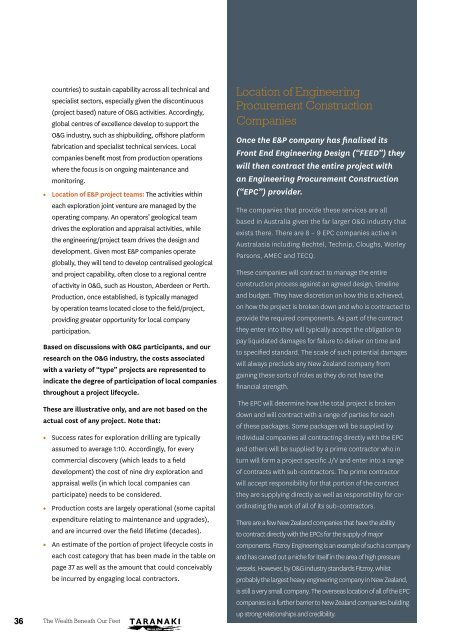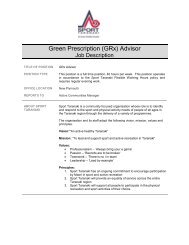The Wealth Beneath Our Feet - full report (6.4 MB ... - Venture Taranaki
The Wealth Beneath Our Feet - full report (6.4 MB ... - Venture Taranaki
The Wealth Beneath Our Feet - full report (6.4 MB ... - Venture Taranaki
You also want an ePaper? Increase the reach of your titles
YUMPU automatically turns print PDFs into web optimized ePapers that Google loves.
36countries) to sustain capability across all technical andspecialist sectors, especially given the discontinuous(project based) nature of O&G activities. Accordingly,global centres of excellence develop to support theO&G industry, such as shipbuilding, offshore platformfabrication and specialist technical services. Localcompanies benefit most from production operationswhere the focus is on ongoing maintenance andmonitoring.••Location of E&P project teams: <strong>The</strong> activities withineach exploration joint venture are managed by theoperating company. An operators’ geological teamdrives the exploration and appraisal activities, whilethe engineering/project team drives the design anddevelopment. Given most E&P companies operateglobally, they will tend to develop centralised geologicaland project capability, often close to a regional centreof activity in O&G, such as Houston, Aberdeen or Perth.Production, once established, is typically managedby operation teams located close to the field/project,providing greater opportunity for local companyparticipation.Based on discussions with O&G participants, and ourresearch on the O&G industry, the costs associatedwith a variety of “type” projects are represented toindicate the degree of participation of local companiesthroughout a project lifecycle.<strong>The</strong>se are illustrative only, and are not based on theactual cost of any project. Note that:••Success rates for exploration drilling are typicallyassumed to average 1:10. Accordingly, for everycommercial discovery (which leads to a fielddevelopment) the cost of nine dry exploration andappraisal wells (in which local companies canparticipate) needs to be considered.••Production costs are largely operational (some capitalexpenditure relating to maintenance and upgrades),and are incurred over the field lifetime (decades).••An estimate of the portion of project lifecycle costs ineach cost category that has been made in the table onpage 37 as well as the amount that could conceivablybe incurred by engaging local contractors.<strong>The</strong> <strong>Wealth</strong> <strong>Beneath</strong> <strong>Our</strong> <strong>Feet</strong>Location of EngineeringProcurement ConstructionCompaniesOnce the E&P company has finalised itsFront End Engineering Design (“FEED”) theywill then contract the entire project withan Engineering Procurement Construction(“EPC”) provider.<strong>The</strong> companies that provide these services are allbased in Australia given the far larger O&G industry thatexists there. <strong>The</strong>re are 8 – 9 EPC companies active inAustralasia including Bechtel, Technip, Cloughs, WorleyParsons, AMEC and TECQ.<strong>The</strong>se companies will contract to manage the entireconstruction process against an agreed design, timelineand budget. <strong>The</strong>y have discretion on how this is achieved,on how the project is broken down and who is contracted toprovide the required components. As part of the contractthey enter into they will typically accept the obligation topay liquidated damages for failure to deliver on time andto specified standard. <strong>The</strong> scale of such potential damageswill always preclude any New Zealand company fromgaining these sorts of roles as they do not have thefinancial strength.<strong>The</strong> EPC will determine how the total project is brokendown and will contract with a range of parties for eachof these packages. Some packages will be supplied byindividual companies all contracting directly with the EPCand others will be supplied by a prime contractor who inturn will form a project specific J/V and enter into a rangeof contracts with sub-contractors. <strong>The</strong> prime contractorwill accept responsibility for that portion of the contractthey are supplying directly as well as responsibility for coordinatingthe work of all of its sub-contractors.<strong>The</strong>re are a few New Zealand companies that have the abilityto contract directly with the EPCs for the supply of majorcomponents. Fitzroy Engineering is an example of such a companyand has carved out a niche for itself in the area of high pressurevessels. However, by O&G industry standards Fitzroy, whilstprobably the largest heavy engineering company in New Zealand,is still a very small company. <strong>The</strong> overseas location of all of the EPCcompanies is a further barrier to New Zealand companies buildingup strong relationships and credibility.






